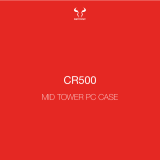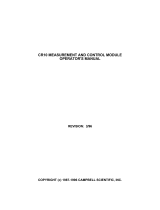Page is loading ...

CAMPBELL
SCIENTIFIC'S
SHORT
CUT:
CREATE
CRl0(X),21X,
CR500'
AND
METDATA1
PROGRAMS
IN MINUTES
Welcome
to Campbell
Scientific's
Short Cut
program
builder
for
CR10(X),
21X, and CR500 dataloggers
and
MetDatal
weather stations.
Using Short
Cut
you
can select
sensors,
choose output
data,
create
wiring
diagrams
and
prepare
reports.
Short
Cut
supports CampbellScientific's
SM192,
SM716,
and CSMl storage
modules.
lmportant
Short Cut
requires a
minimum of 550
Kbytes of unused
conventional
memory.
You can use the
DOS
"mem"
command
and check
the
"largest
executable
program
size."
lf
this number
is
less than 550
K,
you
will need to set
up
your
computer
so
that
it loads boot-up
programs
and drivers
into upper
(or
high)
memory or simply
load
fewer
drivers
(e.g.,
network
or CD-ROM).
Restart
your
computer
to free up
the additional
memory.
Installing Short
Cut
CR500/PC500
users:
Start by
installing PC500.
lts
installation
procedure
will
step
you
through installing Short
Cut.
Refer to the
CR500 manual for
instructions
on using
Short Cut.
Other
users: lnsert
the Short Cut disk
into drive
A:
and
change to that drive.
Type
"install"
at the
DOS
prompt
and
press
Enter.
lt
is
recommended
that
you
accept
default
subdirectories.
MetDatal users: Start
by
installing Short Cut
as described above.
Before
you
write
your
weather station
program,
you
will
need to
run
the batch
file METDATA.BAT
to configure Short
Cut for
your
use.
To use Short
Cut
for
general
datalogger
programs,
run DEFAULT.BAT to
restore Short
Cut
to
its default configuration.
Both
of
the batch
files can
be found in the
subdirectory
where
you
installed
Shott Cut.
Starting
Short
Cut
Windows:
Double-click on SC.EXE
in File Manager or Windows Explorer.
Or,
you
can staft a DOS session by
changing
to the subdirectory
where
you
installed Short
Cut and typing
"SC."
DOS PC208E
or
PC500: lf
you
used the
Oefauit installation
subdirectories, choose
Short Cut
by selecting
it
under
the File main
menu
item. Hint: Establish an association
between
a station and a
program
file under
PC208E's
EDIT I
FILE menu item.
Then, start Short
Cut under the
FILE menu. When
you
return
to
Short
Cut
again
to change
your
program,
Short Cut
will start
using the
filename
you
associated with
the station.
Older
versions
of DOS
PC208: Change to
the subdirectory
where
you
installed Short
Cut and type
"SC"
at
the
DOS
prompt.
GAMPEIELL
SiClENTlFlC,
lNE.
March
13. 1998
Copyright
(C)
1996-1998 Campbell
Scientific,
lnc.

SHORT CUT
Short Cut's main screen leads
you
through
four easy sfeps;
Shoit Cut: Prognam
Builder, u1.0
ritc
Eitir D llelb,, f,x,it
te
a neu talogger
prosran
STEP
1.
OPEN A
PROGRAM WITH AN EIGHT.CHARACTER DOS
FILENAME
Short Cut
will use this name for the
datalogger
program
it
creates.
Hint: lf
you
are using PC208E or
Gr
you
may want to use
the same
name that
you
use
for the
station. When
prompted,
select
your
datalogger
the MetDatal choose CR1O/CR10X.
The datalogger type cannot be changed after this
selection
has
Remember the dynamic help
line
at
the
bottom
of
the
screen and
the
additional
help
provided
by
pressing
function key.
Hint: lf
you
associate the .DLD
file
with the station, Short Cut
will use
the associated
datalogger
program
returning
to review or
change it.

SHORT
CUT
STEP
2,
SELECT
YOUR
SCAN
RATE, SENSORS,
AND
MEASUREMENTS
Shont Cut: frogrili
Builder,
u1.0
:
C:\SC\UFfERDftll'SCf
:
fdit Disi
Ft le
Edtt Dtsplag
t|elp ExIt
Uou
rnag
atld to the
progran
The
first time
you
enter
Step
2,
you
will be
asked for the
Scan
Rate. Press F1lHelp if
you
need
guidance
here.
Select
the sensor
type
(meteorological,
water
quality,
water
level/stage, or
custom),
then
select sensors
from the list
of available
sensors and select
Add. Short Cut supports
most
sensors available
from
CSl.
Remember
to check
Help
(dynamic
and
Fl)tor explanations
if things are
not
clear.
NOTE:
Whenever
you
create or change
a
program
using
Short Cut, a
new .DLD
program
file is
written to
your
disk.
lf
you
had modified
a version of
that
same
program
to
include
VS1 Voice
Synthesizer/Modem
code
or
to
customize
it
in any
way,
those changes
will be
lost when
you
save
the
program
again
from within Short Cut.
Short
Cut; Pro$ran Suilder,
u1.0
i
C:\SC\UfP$ru)ffi.SCI
FiIe
r
Drlit
Hetb Dtit
As
you
add
a sensor
in
Step
2,you willsee the
sensor's
setup screen.
You may
need
to
add details
specific
to
your
sensor,
such
as calibration
information.
You
may
also choose
your
own
input location
labels, which
must be unique
in any
given
program.
(ilqrE)
iCmsrcn.qi
(tc_Drff
.fl)
il
BAlrril{llir
*Ef;
E]!|P.,,,G
#$fifiHl:
1s 8,[
,
roa$;Q
l{Tcnr,Q
zinEFrtrF.{
:
-Y:
:!:!
:::::i:i
:::::::::
uHfiUf,n$lt0

SHORT CUT
STEP 3.
SELECT
OUTPUT
DATA AND INTERVALS
Il:l:lt:i:i:::[dit,
Dl
ttrlu [itt
fl
Help
ouer
output
interual
You may
specify
up
to
three output intervals. First
select
the report
you
want to work
with
among the
windows. The
hot
keys are Alt-1,
Alt-2,
and
Alt-3.
Change the output interval,
if
desired.
Next, select
a
sensor/measurement from the list on the left
followed
by the type of
processing
(sample,
average,
etc.)
from the buttons in the middle
of
the screen. The
output
labels
will
appear
in
the repon
window as they
The
report
for each interval starts
with
an
array
(report)
lD number
and a
time stamp.
lf
you
do
not
add
measurements to a repoft, that repod will be disabled.
STEP
4.
SAVE
PROGRAM, VIEW AND PRINT
WIRING DIAGRAMS, DATA LABELS
MONITORING, AND LISTS
OF OUTPUT
DATA
Short
Cut:
Progran
SuildCr, ul.0
:
C:\$C\UfP[RDA}|.SCI
cn10
f,ii,le,......Edlt, iD Helb
Exit
Use the radio buttons
(check
boxes) on the
right
of the
screen
to
select the
information
you
want
to view.
Print
to
print
a
complete
print-out
of
this information.
AmEg1111t;l),,,,,,,t1 []
,fnan,,,,1,,,:,,,,,,,,,,,,,l:::,:,,:,,,
Dg,11
il,,
titr,,,,,,,,1,11111.,
Htftrl
REFIEIIP-C
SA}trLI
NOTE:
MetDatal users
will
not
find wiring information in Step
4
since
MetDatal stations
have
connectors to make
wiring
even easier.

SHORT
CUT
SENDING
PROGRAM
TO DATALOGGER
The datalogger
program
created by
Short Cut
(filename.DLD)
has the
file name entered
in Step
1 with
the
extension
,DLD.
lt
is already
compiled and
ready
to
be
downloaded to the datalogger.
The
program
must be
loaded into the
datalogger
using
PC208 or
via
a storage
module.
DOS
PC208E:
Open
the
station
for the datalogger.
Then
choose
TOOLS I SEND
DATALOGGER
PROG to send
the
program
to the datalogger.
Windows
PC208W:
After adding
your
station to the
network,
start
a session with the datalogger.
Hint: Select the
Tools tab and
then select Send to download
the
program.
GENERATING
REPORTS USING SPLIT
Short
Cut creates Split
parameter
files for
you
automatically. After
retrieving data,
you
can
generate
reports by
selecting
the
Run
Split option
under FILE I
REPORTS in PC208E.
For
older
versions
of
PC208
you
will
need to run
SPLIT.EXE
at the
DOS
prompt.
For
Windows PC208W, select
"Report"
on
the
toolbar
and choose
File I Open.
ln
your
Short Cut directory
you
will
find Split
parameter
files
created
for each output
interval
you
used
in
Step 3.
PERIODIC OFFSET
ADJUSTM
ENT
Some
sensors
(e.9.,
water
level
and
pH
sensors)
require occasional
offset adjustment
for
accuracy
in
long\erm
monitoring
projects.
Short
Cut makes this
offset adjustment easier
by
pertorming
a measurement,
subtracting
this
measurement
from the
present
or standard
level that
you
enter, and
automatically using the
difference
as
the new
offset.
The
present
or
standard
level is
placed
in a Suatch
lnput Location shown
in Step 4. There are
three
ways
to
adjust the
offset of a sensor
in
a
program generated
by
Short Cut. The
following are
examples
of
adjusting
the
offset
for a water level
measurement.
Option
1.
Using
Short Cut
Enter
the
present
water level
(e.9.,
a staff
gage
reading
in a stream or lake,
or
a chalked tape
reading in a
well)
while
adding or editing the
sensor settings
in Step 2.
Then immediately send the
program
to the datalogger.
Option
2. While
Logging
After
loading the
program
or during
routine site visits
with
a
portable
computer, enter
the real-time
monitoring mode.
DOS
PC208: Key
in the
present
level
using
the "i" input location
load
function
in PC208's
Monitor mode.
Then,
set
the
associated sensor
offset
adjust
flag
(shown
in Step
4) low.
Windows
PC208W:
Right click on
the number
you
want
to change
on the
Numeric Display tab
in a datalogger
session.
For example,
if
the
current
staff
gage
reading
is
6.83
feet, the
associated
scratch
input location
is 29, User
Flag 1 is
the
offset
adjust flag
and
the
water level appears
in Input Location 5
the following computer
keystrokes in
the
PC2O8E
RealTimelMonitor
mode or GraphTerm
monitor mode
will automatically adjust
the offset the
next time the
program
is executed.
Kev
ln
11..33
i
29:6.83<Enter>
Function
key
<Fl>
Response on
screen
Displays
first
33
Inpul Locations
See
bottom
of
screen
See
6.83 in
location
29
See
[F1]
go
from
reverse video
to
normalvideo
(wait for
next
Scan)
See
[F1]
in
reverse
video
and
6.83 appears
in
lnput Loc.
5
Explanation
Tells the monitor
that
you
are
going
to
give
it
a
value
Enters the
value
Resets
Flag 1 low
Flag
1
goes
high
again,
a
new
offset
is
calculated
and
the
level is adjusted

SHOHT CUT
Option 3. Using
Keyboard/Display
Use
the datalogger's keyboard/display. First, identify
the associated staff
gage
Input
Location
and
User
F
4. Then, following
the example
in
Option 2, key
in
the
following:
Key
ln
*6
294
c
6D83A
D
1
(wait)
A
#5A
*0
lD:Data
06:0000
29:0.0000
:0.0000
29:6.8300
10:000000
00:000000
10:000000
29:6.8300
05:6.8300
LOG12
Explanation
Starts
monitor mode
View
Input
Location
29
Enter mode
to change
value
Enter new desired level
View
User Flags
Reset
Flag 1 low
(changes
1 to
0)
The 1 will reappear
the
next
time
the
program
executes.
Viewing
lnput Location 29
View
Input
Location
5: Level
reading
after
offset
has
been adjusted on the
Return to normal logging
"Answe/'file
written
by Short
Cut while
you
are creating
a
program
Compiled
datalogger
program
written by Short
Cut
when
you
save the
program
File written by Short
Cut when
you
save
your
program.
This file
contains
information
the
field
and
is
printed
when
you
select
Print
in
Step
4.
Parameter
file
for
use with
PC2OSlSplit
to
generate
printed
data reports for
output
Parameter
file for use with
PC208/Split
to
generate
printed
data reports
for output
Parameter
file for use with
PC2O8/Split
to
generate
printed
data reports
for output
The
bold
parts
of this
keystroke
sequence represent the example settings.
Note that
the
D key stands
for
decimal
point
when
entering a
numeric
value
using
the datalogger keyboard/display.
Hint: For
the record and to keep track of sensor drift, record the
offset in a daily
repod. The
sensor
method
of installation should be consistent
for offset readings to be meaningtul.
LIST OF SHORT CUT FILES
Short Cut
executable file
Help
files
File Short Cut
uses
to save screen mode, datalogger
type and sensor type
Meteorological sensor
files
Water level sensors
Water
quality
sensors
Custom
modules, such as
an
alarm
or
control
MetDatal system
files
Short
Cut
reconfiguration batch files
Split
parameter
file
for
rainfall
intensity
data
Information
files
you
may find interesting
CR10 datalogger
setup f ile
21X datalogger setup
file
CR500
datalogger setup file
MetDatal
datalogger
setup
file
OTHER FILES WHICH WILL
APPEAR WHEN YOU
RUN SHORT CUT
SC.EXE
*.HLP
..lNl
*.M
*.L
".Q
*.o
-.MD1
-.BAT
RAtN_INT.PAR
-.TXT
cR10.
21X.
cR500.
METDATA.
filename.SCT
filename.DLD
filename.DEF
filenaml.PAR
filenam2.PAR
filenam3.PAR
lf
you
do not
have the
disk files, we will mail the disk to
you
upon
request or
you
can download
Short Cut
following
sources:
FTP: ftp.campbellsci.com
WWW: http:llwww.campbellsci.com
n Step
#1
#2
#3
/


